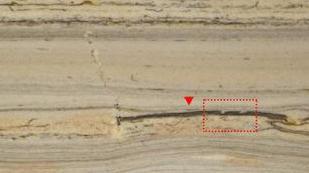
In the long history of Earth's evolution, how life evolved from simple to complex has always been a mystery for scientists. Recently, the "Early Evolution of the Earth-Life System" team of the Nanjing Institute of Geology and Paleontology, Chinese Academy of Sciences, conducted a comprehensive study on a type of disc-shaped fossils from 1.56 billion years ago in the Yanshan area of North my country, and found that this type of well-known difficult fossils is not a multicellular eukaryotic organism as previously believed, but a community formed by microorganisms.
This discovery provides an important new perspective for our understanding of ancient fossils from the Precambrian period. The relevant research results have been recently published in the international academic journal Journal of the Geological Society.

Disc-shaped fossils from the Yanshan region of North China. Photo courtesy of Nanjing Institute of Geology and Paleontology, Chinese Academy of Sciences
Dr. Chen Kai from the Nanjing Institute of Geology and Paleontology, Chinese Academy of Sciences, who participated in the study, said that the disc-shaped fossils of the Precambrian period are a large class of ancient fossils widely found in the early strata of the Earth. They are simple in shape, usually round or oval, with a body length of only a few millimeters, a body length of several centimeters, and even up to the size of an egg. In the past, scientists generally believed that they might be multicellular eukaryotes based on the microscopic structure and internal composition characteristics of individual fossils.

A longitudinal section of a disc-shaped fossil. Photo courtesy of Nanjing Institute of Geology and Paleontology, Chinese Academy of Sciences
This time, the research team conducted morphological measurements, microscopic observations and mineral composition analysis on 466 disc-shaped fossils from 1.56 billion years ago in the Yanshan area of my country. The results showed that no cell structure was found inside these fossils, but there were alternating light and dark laminae composed of dolomite, clay minerals, organic matter, etc. These characteristics indicate that the early disc-shaped fossils were not multicellular individuals, but an aggregate composed of one or more microorganisms and their extracellular matrix, which is what is called a microbial film in biology. This type of microbial film may have been widely distributed in the early history of the Earth, providing microorganisms with a more suitable microenvironment for survival and helping them survive in extreme environments. They are also not uncommon in modern microbiology and can form various regular macroscopic structures, such as round and dendritic.
"This study not only corrects our misunderstanding of these ancient fossils, but more importantly, it provides a new perspective for us to understand Precambrian life forms. With more similar studies, our understanding of the early evolution of life on Earth will become deeper. Perhaps in the future, we will be able to more clearly depict the magnificent picture of life from simple to complex." said Chen Kai.
